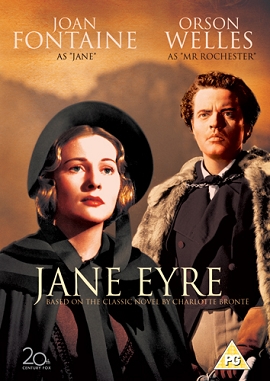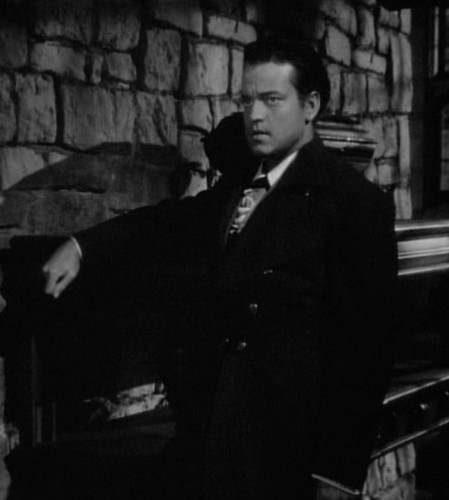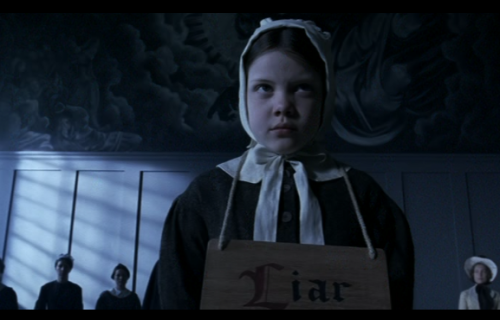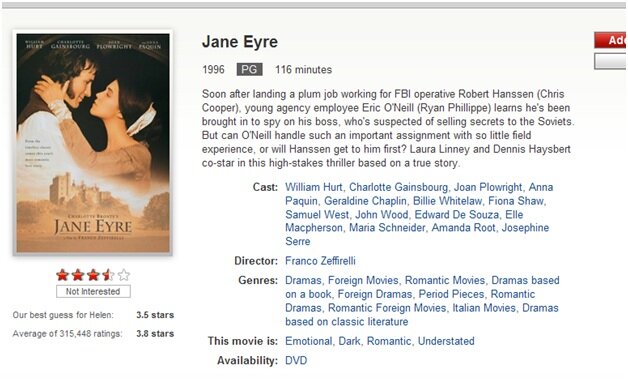What I'm Watching: Jane Eyre (2006)
Hey, kids! Who wants to watch a costume drama that’s a BBC-TV adaptation of a Victorian-era British romance novel???{{insert sounds of crickets chirping}}Erm…hmmmm…OK.Hey, kids! Who wants to watch a movie that explores:Dysfunctional familiesIllegitimacySexBetrayalHomicidal madnessDark family secretsUnrequited loveFeatures a strong, intelligent, independent female leadAnd does all this while the ladies run around in corsets?Well. That’s better.
The BBC did an adaptation of Jane Eyre in 2006 that is all those things and more. It is lush. It is gorgeous. The acting is as near-flawless as you can ask for. And here’s the thing: I am both an old movie junkie and secretly crush  on the young Orson Welles, so the hopes I held were few that this adaptation could touch the 1943, Welles/Joan Fontaine version.May I just say…Touched.I’ve read some of the criticism of this particular version. Most of the reviews were overwhelmingly positive; it stays close to the storyline of the book, there are minimal “made for BBC-TV moments.” Of course, we’ve come to expect some sort of storyline manipulation in filmmaking—I even read a review of a movie made about the Bronte sisters in 1945 that took issue with the filmmaker’s cavalier approach towards historical accuracy. But these are movies, not documentaries…and in the case of this version of Jane Eyre, it’s an interpretation of a fictional story, done 150 years after the book was originally published. One person said that in an effort to give it more modern appeal, they sexed it up, and turned it into “Charlotte Bronte meets Harlequin Romance”. To that person I say, get over it, Puritan. Jane and Rochester were scorchingly in love with each other, and even in Victorian England, folks were getting their freaks on. People from the Victorian Era sent their beloveds secret messages coded in floral arrangements, and did their fair share of erotic writing; sex was never far from anyone’s mind. And really, take another look at the book—once they get engaged, Jane and Rochester make out all over the place.So with that being said, what makes this version as good—for me—as the Orson Welles version? Primarily, I like Jane better. Much is made of Jane’s appearance throughout the book—she is little, she is plain, she is elfin, Rochester even calls her his “mustard seed”. Affectionately, of course. Yes, really. And the 2006 Jane has a quirky look that feels more true to how Jane would have looked (not that Ruth Wilson can’t smoke it up in real life). You can dress Joan Fontaine down in unadorned frocks that cover her from neck to toe and you still won’t be able to escape the fact that she’s the elegant, slightly haughty Joan Fontaine.
on the young Orson Welles, so the hopes I held were few that this adaptation could touch the 1943, Welles/Joan Fontaine version.May I just say…Touched.I’ve read some of the criticism of this particular version. Most of the reviews were overwhelmingly positive; it stays close to the storyline of the book, there are minimal “made for BBC-TV moments.” Of course, we’ve come to expect some sort of storyline manipulation in filmmaking—I even read a review of a movie made about the Bronte sisters in 1945 that took issue with the filmmaker’s cavalier approach towards historical accuracy. But these are movies, not documentaries…and in the case of this version of Jane Eyre, it’s an interpretation of a fictional story, done 150 years after the book was originally published. One person said that in an effort to give it more modern appeal, they sexed it up, and turned it into “Charlotte Bronte meets Harlequin Romance”. To that person I say, get over it, Puritan. Jane and Rochester were scorchingly in love with each other, and even in Victorian England, folks were getting their freaks on. People from the Victorian Era sent their beloveds secret messages coded in floral arrangements, and did their fair share of erotic writing; sex was never far from anyone’s mind. And really, take another look at the book—once they get engaged, Jane and Rochester make out all over the place.So with that being said, what makes this version as good—for me—as the Orson Welles version? Primarily, I like Jane better. Much is made of Jane’s appearance throughout the book—she is little, she is plain, she is elfin, Rochester even calls her his “mustard seed”. Affectionately, of course. Yes, really. And the 2006 Jane has a quirky look that feels more true to how Jane would have looked (not that Ruth Wilson can’t smoke it up in real life). You can dress Joan Fontaine down in unadorned frocks that cover her from neck to toe and you still won’t be able to escape the fact that she’s the elegant, slightly haughty Joan Fontaine.
 As for Rochester, it’s hard to tear yourself away from Orson “Mr. Brooding Intensity” Welles, but Toby Stephens gives him a run for the money. He’s not quite as intense as Welles, but making that comparison is sort of like saying the moon is not quite as bright as the sun. Few actors come near that intensity. Instead, Toby Stephens brings out the vulnerability in Rochester that is woven through the storyline of the book but gets lost in Welles’s personal bombast. And one of my favorite scenes in the new film is when we see Rochester’s insane wife in her tower room; in the 1943 version, we only see her hands, when she makes a raving-mad and screaming lunge towards Jane and of course, the audience hates her instantly. In the 2006 version, she still lunges after Jane but first, we see her placid and beautiful, and when her madness wells up you find new understanding and sympathy for both her plight and Rochester’s. It’s a short but impressive moment, and covers a lot of ground in a brief period of time.
As for Rochester, it’s hard to tear yourself away from Orson “Mr. Brooding Intensity” Welles, but Toby Stephens gives him a run for the money. He’s not quite as intense as Welles, but making that comparison is sort of like saying the moon is not quite as bright as the sun. Few actors come near that intensity. Instead, Toby Stephens brings out the vulnerability in Rochester that is woven through the storyline of the book but gets lost in Welles’s personal bombast. And one of my favorite scenes in the new film is when we see Rochester’s insane wife in her tower room; in the 1943 version, we only see her hands, when she makes a raving-mad and screaming lunge towards Jane and of course, the audience hates her instantly. In the 2006 version, she still lunges after Jane but first, we see her placid and beautiful, and when her madness wells up you find new understanding and sympathy for both her plight and Rochester’s. It’s a short but impressive moment, and covers a lot of ground in a brief period of time.


 The 1943 version features a very young Elizabeth Taylor as Jane’s best friend, Helen, so that’s sort of fun. The 2006 version features Georgie Henley as childhood Jane, and even though by the end of The Chronicles of Narnia I was hoping Tilda Swinton and the polar bears would win, it was hard in this movie to watch little Lucy Pevensie get knocked around by the hateful Aunt Reed and family. The Welles version is only 97 minutes long, so the plot point that fuels the last third of the book is jettisoned and other points of the story are rearranged to provide a refuge for Jane when she leaves Rochester. The 2006 version has a running time of 202 minutes, so the St. John part of the story is restored and the timeline of the book remains pretty well intact.And here is my confession: between the 1943 Orson Welles version and the 2006 version? Much to my surprise, I like 2006 better. I didn’t think it could be done and yet, such is the truth.Watch this if:You like costume dramas.You have 202 minutes to spare, somewhere along the line (it is broken into four episodes, you know).You like stories involving orphans.Movies from 1943 don’t really do it for you.You like stories about homicidal wives in towers.Don’t watch this if:Corsets are not your thing.You see no reason for a movie to go any longer than 97 minutes.You are a black & white purist.You only like movies where shit blows up good.You’ve got no problem with a little betrayal among family members.And finally…when I was on Netflix looking at the many and various adaptations of Jane Eyre, I noticed what can only be a computer glitch, as the totally wrong synopsis appeared for the 1996 version…unless, of course, there is a sequel to Jane Eyre which is something like Jane Eyre: Code Name: Governess.
The 1943 version features a very young Elizabeth Taylor as Jane’s best friend, Helen, so that’s sort of fun. The 2006 version features Georgie Henley as childhood Jane, and even though by the end of The Chronicles of Narnia I was hoping Tilda Swinton and the polar bears would win, it was hard in this movie to watch little Lucy Pevensie get knocked around by the hateful Aunt Reed and family. The Welles version is only 97 minutes long, so the plot point that fuels the last third of the book is jettisoned and other points of the story are rearranged to provide a refuge for Jane when she leaves Rochester. The 2006 version has a running time of 202 minutes, so the St. John part of the story is restored and the timeline of the book remains pretty well intact.And here is my confession: between the 1943 Orson Welles version and the 2006 version? Much to my surprise, I like 2006 better. I didn’t think it could be done and yet, such is the truth.Watch this if:You like costume dramas.You have 202 minutes to spare, somewhere along the line (it is broken into four episodes, you know).You like stories involving orphans.Movies from 1943 don’t really do it for you.You like stories about homicidal wives in towers.Don’t watch this if:Corsets are not your thing.You see no reason for a movie to go any longer than 97 minutes.You are a black & white purist.You only like movies where shit blows up good.You’ve got no problem with a little betrayal among family members.And finally…when I was on Netflix looking at the many and various adaptations of Jane Eyre, I noticed what can only be a computer glitch, as the totally wrong synopsis appeared for the 1996 version…unless, of course, there is a sequel to Jane Eyre which is something like Jane Eyre: Code Name: Governess. I’m not sure when she begins her career as a spy; perhaps among the things she inherits from her long-lost uncle is a secret decoder ring?UPDATE: The 2011 version with Mia Wasikowska? It's so not very good. I never believe her as Jane, and Michael Fassbender as Rochester is neither compelling nor interesting.
I’m not sure when she begins her career as a spy; perhaps among the things she inherits from her long-lost uncle is a secret decoder ring?UPDATE: The 2011 version with Mia Wasikowska? It's so not very good. I never believe her as Jane, and Michael Fassbender as Rochester is neither compelling nor interesting.
 on the young Orson Welles, so the hopes I held were few that this adaptation could touch the 1943, Welles/Joan Fontaine version.May I just say…Touched.I’ve read some of the criticism of this particular version. Most of the reviews were overwhelmingly positive; it stays close to the storyline of the book, there are minimal “made for BBC-TV moments.” Of course, we’ve come to expect some sort of storyline manipulation in filmmaking—I even read a review of a movie made about the Bronte sisters in 1945 that took issue with the filmmaker’s cavalier approach towards historical accuracy. But these are movies, not documentaries…and in the case of this version of Jane Eyre, it’s an interpretation of a fictional story, done 150 years after the book was originally published. One person said that in an effort to give it more modern appeal, they sexed it up, and turned it into “Charlotte Bronte meets Harlequin Romance”. To that person I say, get over it, Puritan. Jane and Rochester were scorchingly in love with each other, and even in Victorian England, folks were getting their freaks on. People from the Victorian Era sent their beloveds secret messages coded in floral arrangements, and did their fair share of erotic writing; sex was never far from anyone’s mind. And really, take another look at the book—once they get engaged, Jane and Rochester make out all over the place.So with that being said, what makes this version as good—for me—as the Orson Welles version? Primarily, I like Jane better. Much is made of Jane’s appearance throughout the book—she is little, she is plain, she is elfin, Rochester even calls her his “mustard seed”. Affectionately, of course. Yes, really. And the 2006 Jane has a quirky look that feels more true to how Jane would have looked (not that Ruth Wilson can’t smoke it up in real life). You can dress Joan Fontaine down in unadorned frocks that cover her from neck to toe and you still won’t be able to escape the fact that she’s the elegant, slightly haughty Joan Fontaine.
on the young Orson Welles, so the hopes I held were few that this adaptation could touch the 1943, Welles/Joan Fontaine version.May I just say…Touched.I’ve read some of the criticism of this particular version. Most of the reviews were overwhelmingly positive; it stays close to the storyline of the book, there are minimal “made for BBC-TV moments.” Of course, we’ve come to expect some sort of storyline manipulation in filmmaking—I even read a review of a movie made about the Bronte sisters in 1945 that took issue with the filmmaker’s cavalier approach towards historical accuracy. But these are movies, not documentaries…and in the case of this version of Jane Eyre, it’s an interpretation of a fictional story, done 150 years after the book was originally published. One person said that in an effort to give it more modern appeal, they sexed it up, and turned it into “Charlotte Bronte meets Harlequin Romance”. To that person I say, get over it, Puritan. Jane and Rochester were scorchingly in love with each other, and even in Victorian England, folks were getting their freaks on. People from the Victorian Era sent their beloveds secret messages coded in floral arrangements, and did their fair share of erotic writing; sex was never far from anyone’s mind. And really, take another look at the book—once they get engaged, Jane and Rochester make out all over the place.So with that being said, what makes this version as good—for me—as the Orson Welles version? Primarily, I like Jane better. Much is made of Jane’s appearance throughout the book—she is little, she is plain, she is elfin, Rochester even calls her his “mustard seed”. Affectionately, of course. Yes, really. And the 2006 Jane has a quirky look that feels more true to how Jane would have looked (not that Ruth Wilson can’t smoke it up in real life). You can dress Joan Fontaine down in unadorned frocks that cover her from neck to toe and you still won’t be able to escape the fact that she’s the elegant, slightly haughty Joan Fontaine.
 As for Rochester, it’s hard to tear yourself away from Orson “Mr. Brooding Intensity” Welles, but Toby Stephens gives him a run for the money. He’s not quite as intense as Welles, but making that comparison is sort of like saying the moon is not quite as bright as the sun. Few actors come near that intensity. Instead, Toby Stephens brings out the vulnerability in Rochester that is woven through the storyline of the book but gets lost in Welles’s personal bombast. And one of my favorite scenes in the new film is when we see Rochester’s insane wife in her tower room; in the 1943 version, we only see her hands, when she makes a raving-mad and screaming lunge towards Jane and of course, the audience hates her instantly. In the 2006 version, she still lunges after Jane but first, we see her placid and beautiful, and when her madness wells up you find new understanding and sympathy for both her plight and Rochester’s. It’s a short but impressive moment, and covers a lot of ground in a brief period of time.
As for Rochester, it’s hard to tear yourself away from Orson “Mr. Brooding Intensity” Welles, but Toby Stephens gives him a run for the money. He’s not quite as intense as Welles, but making that comparison is sort of like saying the moon is not quite as bright as the sun. Few actors come near that intensity. Instead, Toby Stephens brings out the vulnerability in Rochester that is woven through the storyline of the book but gets lost in Welles’s personal bombast. And one of my favorite scenes in the new film is when we see Rochester’s insane wife in her tower room; in the 1943 version, we only see her hands, when she makes a raving-mad and screaming lunge towards Jane and of course, the audience hates her instantly. In the 2006 version, she still lunges after Jane but first, we see her placid and beautiful, and when her madness wells up you find new understanding and sympathy for both her plight and Rochester’s. It’s a short but impressive moment, and covers a lot of ground in a brief period of time.


 The 1943 version features a very young Elizabeth Taylor as Jane’s best friend, Helen, so that’s sort of fun. The 2006 version features Georgie Henley as childhood Jane, and even though by the end of The Chronicles of Narnia I was hoping Tilda Swinton and the polar bears would win, it was hard in this movie to watch little Lucy Pevensie get knocked around by the hateful Aunt Reed and family. The Welles version is only 97 minutes long, so the plot point that fuels the last third of the book is jettisoned and other points of the story are rearranged to provide a refuge for Jane when she leaves Rochester. The 2006 version has a running time of 202 minutes, so the St. John part of the story is restored and the timeline of the book remains pretty well intact.And here is my confession: between the 1943 Orson Welles version and the 2006 version? Much to my surprise, I like 2006 better. I didn’t think it could be done and yet, such is the truth.Watch this if:You like costume dramas.You have 202 minutes to spare, somewhere along the line (it is broken into four episodes, you know).You like stories involving orphans.Movies from 1943 don’t really do it for you.You like stories about homicidal wives in towers.Don’t watch this if:Corsets are not your thing.You see no reason for a movie to go any longer than 97 minutes.You are a black & white purist.You only like movies where shit blows up good.You’ve got no problem with a little betrayal among family members.And finally…when I was on Netflix looking at the many and various adaptations of Jane Eyre, I noticed what can only be a computer glitch, as the totally wrong synopsis appeared for the 1996 version…unless, of course, there is a sequel to Jane Eyre which is something like Jane Eyre: Code Name: Governess.
The 1943 version features a very young Elizabeth Taylor as Jane’s best friend, Helen, so that’s sort of fun. The 2006 version features Georgie Henley as childhood Jane, and even though by the end of The Chronicles of Narnia I was hoping Tilda Swinton and the polar bears would win, it was hard in this movie to watch little Lucy Pevensie get knocked around by the hateful Aunt Reed and family. The Welles version is only 97 minutes long, so the plot point that fuels the last third of the book is jettisoned and other points of the story are rearranged to provide a refuge for Jane when she leaves Rochester. The 2006 version has a running time of 202 minutes, so the St. John part of the story is restored and the timeline of the book remains pretty well intact.And here is my confession: between the 1943 Orson Welles version and the 2006 version? Much to my surprise, I like 2006 better. I didn’t think it could be done and yet, such is the truth.Watch this if:You like costume dramas.You have 202 minutes to spare, somewhere along the line (it is broken into four episodes, you know).You like stories involving orphans.Movies from 1943 don’t really do it for you.You like stories about homicidal wives in towers.Don’t watch this if:Corsets are not your thing.You see no reason for a movie to go any longer than 97 minutes.You are a black & white purist.You only like movies where shit blows up good.You’ve got no problem with a little betrayal among family members.And finally…when I was on Netflix looking at the many and various adaptations of Jane Eyre, I noticed what can only be a computer glitch, as the totally wrong synopsis appeared for the 1996 version…unless, of course, there is a sequel to Jane Eyre which is something like Jane Eyre: Code Name: Governess. I’m not sure when she begins her career as a spy; perhaps among the things she inherits from her long-lost uncle is a secret decoder ring?UPDATE: The 2011 version with Mia Wasikowska? It's so not very good. I never believe her as Jane, and Michael Fassbender as Rochester is neither compelling nor interesting.
I’m not sure when she begins her career as a spy; perhaps among the things she inherits from her long-lost uncle is a secret decoder ring?UPDATE: The 2011 version with Mia Wasikowska? It's so not very good. I never believe her as Jane, and Michael Fassbender as Rochester is neither compelling nor interesting.